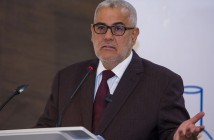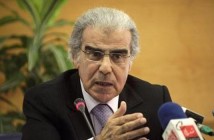
New York City is just days away from a long-awaited Arab autumn.
In 2003 the Islamic galleries of theMetropolitan Museum of Art closed for renovation, and one of the world’s premier collections of Islamic art more or less vanished into storage.
The timing, barely two years after the events of Sept. 11, was unfortunate, if unavoidable. Just when we needed to learn everything we could about Islamic culture, a crucial teaching tool disappeared.
As of Tuesday the learning can go forward. The Met’s Islamic collection returns to view in what are now being called the galleries for the Art of the Arab Lands, Turkey, Iran, Central Asia and Later South Asia.
The new, much expanded installation — organized by Sheila Canby, the curator in charge of the department of Islamic art, with Navina Najat Haidar as project coordinator — is as intelligent as it is visually resplendent. The art itself, some 1,200 works spanning more than 1,000 years, is beyond fabulous. An immense cultural vista — necessary, liberating, intoxicatingly pleasurable — has been restored to the city.
As its title implies, that vista has been carefully thought out and framed. Rather than presenting Islamic art as the product of a religiously driven monoculture encompassing centuries and continents, the Met is now — far more realistically — approaching it as a varied, changing, largely secular phenomenon, regionally rooted but absorptively cosmopolitan, affected by the intricacies and confusions of history, including the history that the art itself helped to create.
At the same time certain visual binders are evident. You see one — language — the instant you enter the first gallery. The written word is omnipresent. Whether in the form of love poems, proverbs or passages from Islam’s holy book, the Koran, calligraphy spreads like a fine net over everything, creating an art that almost literally speaks.
“Praise be to God, the King, the pure Truth,” declares a precious scrap of ninth-century silk in characters stitched in red thread. “Planning before work protects you from regret,” intones a big white 10th-century plate that, given the perfect placement of the inscription around its rim, seems to have heeded its own advice. And from a gloriously colored openwork jug — turquoise on top of cobalt blue, day on top of night — a voice as soft as a sigh shares a lover’s confidence: “One moment, while sitting face to face with her I tied my soul, like my heart, to the end of her curls.”
In the context of Islamic art, language is transferable to almost any surface, on almost any scale. And some insist that you can’t really know this art until you’ve experienced Islamic architecture: grand palaces like the Alhambra, tombs like the Taj Mahal or houses of worship like the Suleymaniye Mosque in Istanbul, all embroidered with inscriptions.
The Met galleries convey some sense of monumentality in a few long-familiar works. The great 11-foot-high mosaic-tiled 14th-century mihrab, or prayer niche, from a religious school in Isfahan is one. The intact wood-paneled reception hall known as the Damascus Room, decorated with poetic verses that have been placed in proper order with this reinstallation, is another.
Then there are carpets, portable monuments. The Met has spectacular examples. The Simonetti Carpet, woven around 1500 in Cairo and named for a 20th-century owner, is nearly 30 feet long. In dim quarters in the old Islamic galleries it was hard to appreciate. Now displayed in a high, wide room designed by Michael Batista, the Met’s exhibition design manager, and atmospherically lighted by Clint Ross Coller and Richard Lichte, its garden-and-lawn colors — rose reds, grass greens — look tender with fresh life.
Carpets like this one, emerging from imperial ateliers, are partly about look-at-me largeness. But they’re also about close-up detail, and this is the real story of the art of the Islamic world, and certainly of the examples gathered at the Met.
It is over all an art of intimacy; about one-on-one encounters with individual objects, more often than not quite small; and about the endlessly varied orchestration of a small number of visual motifs and mediums, and the minute felicities such variation generates. The alert eye will spot some of the motifs right away: besides the written word, there are images of stars, flowers, figures and abstract shapes, each migrating from one kind of object to another within a fixed repertory of mediums: textiles, ceramics, manuscripts, and so on.
Choose any motif or medium, and it will set you traveling. Images of animals will take you from a gnarled little camel-shaped bottle made with Roman glassmaking techniques in Syria in the seventh or eighth century, to a hefty lion-shaped bronze incense burner from 12th-century Iran, to a sculptural knot of predatory beasts — a dragon attacking a lion attacking a deer — perched on the hilt of a 16th-century Indian dagger.
A gallery of Ottoman Turkish art is a floral detonation, with blossoms imported from China, Persia, India and Europe streaming over textiles and landing on plates, helmets and the most beautiful prayer rug in the world. If glass is your passion, a lineup of mosque lamps, enameled and translucent, from Egypt and Syria will be heaven.
Metalwork connoisseurs will beat a path to a 13th-century brass brazier inlaid with impossibly refined silver and copper designs, and to an astrolabe that calculates your geographic coordinates, your horoscope and the precise times for daily prayer.
If your point of reference in art is the human form, you’ll find it — aggressive, ethereal and absurd — in manuscript paintings, the most famous being illustrations for the 16th-century edition of the “Shahnama,” or “Book of Kings,” produced under the art-obsessed and faith-obsessed Persian emperor Shah Tahmasp.
Written around A.D. 1000 as a chronicle of the pre-Islamic kings of Iran, the “Shahnama,” at least in painters’ hands, is history set in a Never Never Land of martial derring-do and mystical raptures. Heroes skewer demons in lavender landscapes; angels drop from gilded skies to help when things go awry. In the 16th-century edition’s very first painting, “The Ship of Shi’ism,” the Prophet Muhammad appears, his face veiled and wreathed in a halo of flames, as if to extend blessings over what will follow.
For more than four centuries those blessings held, but the book’s modern history has been a disaster. In 1959 the American collector Arthur A. Houghton Jr. bought the “Shahnama” with its original 258 paintings still miraculously intact. Then, committing what some scholars consider one of the notable art crimes of the 20th century, he took the book apart and began dispersing its pages; he gave 78 sheets to the Met and auctioned others. After his death in 1990 his estate tried to sell surviving pages of the book to the Iranian government but ended up exchanging them for an American painting that Iran owned but no longer wanted, Willem de Kooning’s “Women III” from 1952-53. A good deal? You can judge for yourself with a visit to the de Kooning retrospective at the Museum of Modern Art.
The Met’s Islamic reinstallation, which includes (temporarily) a somewhat obsequious tribute to collectors past and present, is mum on all of this, as is the collection catalog, doubtless in part because Mr. Houghton was a long-time Met trustee. Also the story is old, and not so unusual.
Art has always reflected what’s wrong about people as much as what’s right about them. In image after image, beauty is countered by cruelty; utopianism by power grabs. Paradise gardens and battlefields make equally desirable real estate. Yet if treasured objects almost invariably come with ethical ambiguities, one thing is certain: Those objects do keep coming, as recent arrivals attest.
One, on loan to the Met from the Hispanic Society of America, is a tiny Hebrew bible written by a Sephardic scribe named Moshe b. Ya’akov Qalif. When he was working in Seville, in 1472, the once pervasive Muslim presence barely clung to life in Spain, yet the exquisite micrographic interlaces that adorn and shape his text are almost identical to those in Koranic illuminations.
And in the last of the new galleries, devoted to Islamic art in South Asia, comes a 2011 Met acquisition that’s a real surprise. It’s album painting with a Hindu theme: the fierce goddess Bhairavi dancing up a spiritual storm in a cremation ground. The picture is thought to have been a collaboration between two 17th-century Mughal court painters, Payag and Abid, one Hindu, the other Muslim. It was probably commissioned by the Muslim emperor Shah Jahan as a gift to a friend, the Hindu ruler Rana Jagat Singh, who worshipped the goddess.
Here — and over and over again through 15 galleries and across more than a millennium — we’re reminded how fluid a concept Islamic art can be, and often is. If we could ask for only one lesson learned from the decade since the Sept. 11 attacks, surely freedom from essentialist thinking would be the necessary one. That’s the direction the Met’s new galleries take us this fall. In the bargain they give us beauty, spring fresh and second to none.






